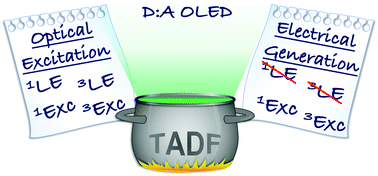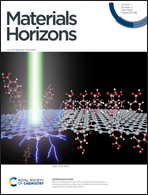Optically and electrically excited intermediate electronic states in donor:acceptor based OLEDs†
Abstract
Thermally activated delayed fluorescence (TADF) emitters consisting of donor and acceptor molecules are potentially highly interesting for electroluminescence (EL) applications. Their strong fluorescence emission is considered to be due to reverse intersystem crossing (RISC), in which energetically close triplet and singlet charge transfer (CT) states, also called exciplex states, are involved. In order to distinguish between different mechanisms and excited states involved, temperature-dependent spin-sensitive measurements on organic light-emitting diodes (OLEDs) and thin films are essential. In our work we apply continuous wave (cw) and time-resolved (tr) photoluminescence (PL) spectroscopy as well as spin-sensitive EL and PL detected magnetic resonance to films and OLED devices made of three different donor:acceptor combinations. Our results clearly show that triplet exciplex states are formed and contribute to delayed fluorescence (DF) via RISC in both electrically driven OLEDs and optically excited films. In the same sample set we also found molecular triplet excitons, which occurred only in PL experiments under optical excitation and for some material systems only at low temperatures. We conclude that in all investigated molecular systems exciplex states formed at the donor:acceptor interface are responsible for TADF in OLEDs with distinct activation energies. Molecular (local) triplet exciton states are also detectable, but only under optical excitation, while they are not found in OLEDs when excited states are generated electrically. We believe that the weakly bound emissive exciplex states and the strongly bound non-emissive molecular triplet excited states coexist in the TADF emitters, and it is imperative to distinguish between optical and electrical generation paths as they may involve different intermediate excited states.

- This article is part of the themed collection: Horizons Community Board Collection: Advanced Memory Technologies


 Please wait while we load your content...
Please wait while we load your content...